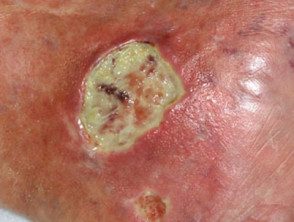What is Martorell? ulcer?
A Martorell ulcer is a very painful ulcer of the lower leg that develops in association with poorly controlled high blood pressure. Also called Martorell's hypertensive leg ulcer, Martorell arteriosclerotic ulcer and hypertensive Martorell ischemic leg ulcer (Martorell HYTILU).
Martorell ulcer

Martorell ulcer

Martorell ulcer

Martorell ulcer
Who gets Martorell ulcer and why?
Martorell ulcers they occur in patients with long-standing and often poorly controlled arterial hypertension. There is an additional association with diabetes mellitus. Martorell ulcers affect women more than men. Most patients are between 50 and 60 years old, with an age range of 41 to 86 years.
The ulcer is believed to result from the narrowing of small blood vessels located in the skin, which increases resistance to blood flow and lack of blood supply to the skin, resulting in skin death. Also, the blood vessels cannot open up to allow an increased blood supply. This is the most peripheral form of arterial vascular disease.
Clinical characteristics of Martorell's ulcer.
Martorell ulcers most often occur on the outer aspect of the back of the lower leg, often just above the ankle. Over the Achilles tendon is another common site.
A significant proportion of patients report that the ulcer started after the skin. trauma, but most commonly begins as a painful red blister or patch which turns blue and then ulcerates.
Characteristics of the ulcer may include:
- Extreme pain out of proportion to the size and appearance of the ulcer – usually described as “severe to excruciating”
- Solitaire or symmetrical, affecting the same site on both legs
- Purple red inflamed ulcer edge
- Sudden enlargement episodes due to another area of skin death.
- Irregular shape
- Satellite ulcers.
- Deep, exposing underlying tendons
- Not responding to the usual treatments for leg ulcers.
These ulcers usually occur in the absence of arteries or venous disease.
Extensive ulceration is associated with a poor outcome.
How is Martorell ulcer diagnosed?
Martorell's ulcer should be considered clinically when a patient with longstanding high blood pressure develops very painful leg ulcers on the outer aspect of the lower leg or over the Achilles tendon. There is no significant disease affecting arteries or veins. Patients with Martorell's ulcer do not have pain at rest, nor are they intermittent. claudication (pain in the calf muscles when walking). In addition, they do not suffer from kidney disease, so calciphylaxis is excluded.
A narrow and deep elliptical incisional skin biopsy across the edge of the ulcer to include both normal skin and the ulcer, and extends downward subcutaneous fat shows thickening of the arteriolar walls, often with calcium deposits that may mimic calciphylaxis. There is not inflammation of the blood vessels. A puncture biopsy since the ulcer does not extend deep enough to find these characteristic changes, the diagnosis may be missed.
blood tests like C-reactive protein and the white blood cell count may be elevated.
Treatment of Martorell's ulcer
The treatment consists of two parts:
- Best control blood pressure using drugs that open the blood vessels and do not cause constriction of blood vessels. Therefore, non-specific beta-blockers should be stopped and, if possible, use calcium channel blockers, specific beta-blockers and ACE inhibitors. A large case series has shown that even a small reduction in blood pressure can have a major impact on pain and ulcer healing.
- Ulcer care usually includes surgery debridement along with compression therapy, subatmospheric pressure technique (vacuum-assisted closure) and, for large ulcers, skin grafting. Skin grafting leads to a rapid improvement in pain.
Pain relief is required and then reduced as pain improves with proper ulcer treatment. Paracetamol and other non-steroidal anti-steroidsinflammatory Medications are often sufficient, but narcotic (opioid) analgesics may be needed initially for severe pain.
Antibiotics may be required for secondary bacterial wound infection.
The role of anticoagulant therapy (anticoagulants) and sympathectomy (procedure in which sympathetic nerve fibers are cut) is not clear at this time.
Preventive measures to reduce the risk of developing Martorell's ulcer may include:
- give up smoking
- compression socks
- trauma protection.
This is an important diagnosis to think about if pyoderma Gangrenous is being considered as the treatments are quite different. Immunosuppression is associated with poor forecast in Martorell's ulcer.
